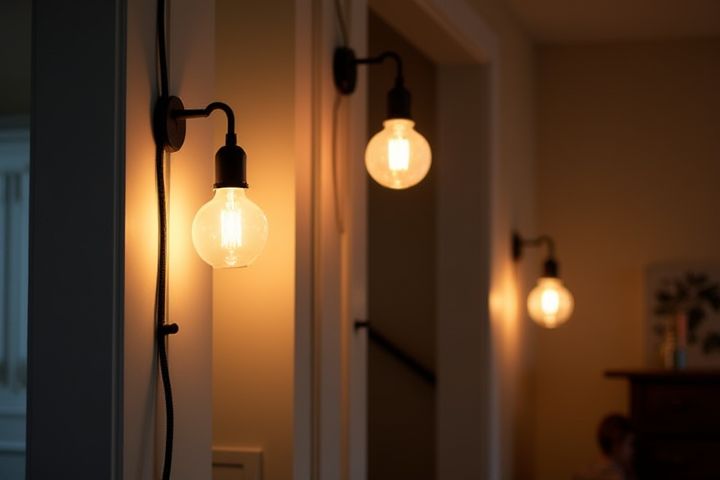
Consider updating your house lighting when you notice increased energy bills or if your current fixtures are outdated and inefficient. Modern LED lights offer significant energy savings and longer lifespans, making them a smart choice for both sustainability and cost-effectiveness. If you're renovating or redecorating, changing your lighting can enhance the overall aesthetic and functionality of the space. Smart lighting systems allow you to control brightness and color temperature via smartphone apps, providing convenience and customization for your home. Regularly assessing your lighting helps create a comfortable atmosphere and ensures your home remains welcoming and visually appealing.
When To Update House Lighting
Increased energy bills
Updating your house lighting can significantly reduce your energy bills, which can rise by as much as 10-30% without efficient fixtures. Transitioning to LED bulbs, which use up to 75% less electricity, can yield savings of approximately $225 per year for the average household. Consider retrofitting your home with smart lighting systems that enable you to control usage remotely; such solutions can enhance energy efficiency by optimizing when and where lights are used. If you notice a spike in your energy expenses, it's a clear signal to reassess your lighting options and invest in modern solutions that provide both sustainability and cost savings.
Dim or flickering lights
Dim or flickering lights in your home can indicate underlying electrical issues, often requiring immediate attention. If your lights lose brightness or flicker consistently, it could signify outdated fixtures or a problem with wiring, potentially affecting energy efficiency. Regularly inspecting your home's lighting every few years is advisable, especially in older properties, to maintain optimal performance. Upgrading to LED bulbs not only enhances illumination but also reduces electricity consumption by up to 75%.
Frequent bulb replacements
Frequent bulb replacements indicate it may be time to update your house lighting, especially if you find yourself changing bulbs every few months. Consider switching to LED bulbs, which last up to 25,000 hours and use 75% less energy than traditional incandescent bulbs, drastically reducing maintenance costs. If you experience flickering or dimming in your current fixtures, it might be a sign they are outdated or incompatible with modern technology. Evaluating the age and efficiency of your lighting system can significantly enhance your home's ambiance and energy efficiency.
Outdated or unsafe fixtures
Outdated or unsafe lighting fixtures can pose significant safety hazards and lower your home's aesthetic appeal. If your fixtures are more than 10 years old or exhibit signs of wear, such as flickering or corrosion, it may be the right time to replace them. You should also consider upgrading to energy-efficient LED bulbs, which can reduce your electricity usage by up to 75%, resulting in substantial cost savings over time. Regularly inspect your lighting to ensure it meets safety standards and complements your home's modern style.
Desire for smart home integration
Updating your house lighting can significantly enhance your smart home integration experience. A survey conducted in 2023 revealed that 65% of homeowners prefer using smart lighting systems that can be controlled via mobile apps or voice commands. Consider replacing traditional bulbs with LED smart bulbs, which typically consume 75% less energy and last up to 25,000 hours. This upgrade not only elevates your home's aesthetic with customizable colors but also improves energy efficiency, potentially saving you upwards of $250 annually on electricity bills.
Insufficient lighting for activities
Insufficient lighting can hinder various activities, such as reading, cooking, or working from home. It's essential to evaluate your space if you notice frequent eye strain or difficulty performing tasks at night. Consider upgrading to brighter LED fixtures or adding task-specific lighting, like desk lamps or under-cabinet lights, to improve visibility in key areas. Regularly assessing your home lighting ensures that it meets your needs and enhances the overall ambiance.
Home renovation or redesign
During home renovation or redesign, consider updating your house lighting to enhance aesthetics and functionality. Upgrading to energy-efficient LED fixtures can reduce energy consumption by up to 75%, significantly lowering your utility bills. Incorporating smart lighting solutions allows for customizable settings, enabling you to adjust brightness and color temperature based on mood or occasion. Aim to install multiple light sources, such as ambient, task, and accent lighting, to create a balanced and inviting atmosphere throughout your living spaces.
Transition to LED technology
Transitioning to LED technology for your house lighting is recommended when your current bulbs are nearing the end of their lifespan, typically around 1,000 hours for incandescent bulbs. If you notice rising energy bills, replacing outdated lighting with energy-efficient LEDs can result in significant cost savings, as they use up to 80% less energy. Additionally, if you frequently replace burnt-out bulbs, switching to LEDs will provide remarkable longevity, with most lasting over 25,000 hours. Consider upgrading your home lighting during seasonal changes or renovations to enhance your living spaces while improving energy efficiency.
New lighting trends and styles
Consider updating your house lighting if it's been over 10 years since your last upgrade, as trends frequently evolve every few years. In 2023, popular styles include smart lighting systems that offer customizable options, allowing you to control brightness and color via apps or voice commands. Pendant lights and LED strip lighting are in vogue, enhancing both functionality and aesthetics for modern living spaces. To stay current, reviewing your lighting every 5 years will ensure your home reflects the latest design trends and energy-efficient technologies.
Changed lighting needs due to lifestyle adjustments
Updating your house lighting is essential when your lifestyle undergoes significant changes, such as having a baby or transitioning to remote work. For instance, adding dimmable fixtures can create a calming atmosphere for evening family activities, while task lighting is crucial for home office productivity during the day. If you frequently host gatherings, consider brightening communal areas with adjustable LED lights that enhance ambiance. A modern lighting system not only improves functionality but can also reduce energy costs by up to 75% compared to traditional incandescent bulbs.
